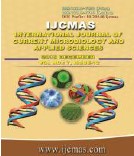


 National Academy of Agricultural Sciences (NAAS)
National Academy of Agricultural Sciences (NAAS)

|
PRINT ISSN : 2319-7692
Online ISSN : 2319-7706 Issues : 12 per year Publisher : Excellent Publishers Email : editorijcmas@gmail.com / submit@ijcmas.com Editor-in-chief: Dr.M.Prakash Index Copernicus ICV 2018: 95.39 NAAS RATING 2020: 5.38 |
The experiment was conducted with 6 genotypes of Indian mustard (Brassica juncea L.) viz RH-0116, RH-725, RH-923, RH-1019, RH-1077, RH-1301 for three dates of sowing i.e 23 September, 16 October and 21 November in the field in randomized block design during rabi season of 2015-16 at Oil Seed Section, Chaudhary Charan Singh Haryana Agricultural University, Hisar with an objective was to study the changes for the physiological traits like water potential, osmotic potential, relative water content, relative stress injury, canopy temperature depression and chlorophyll a fluorescence and biochemical traits like proline and glycine betaine content. The values of all the physiological traits were maximum on 16 October sowing and minimum on 21 November sowing except relative stress injury which was maximum on 21 November and minimum on 16 October and the canopy temperature depression was maximum on 23 September sowing and minimum on 16 October sowing. The accumulation of proline and glycine betaine content was maximum on 21 November sowing and minimum on 16 October. Results showed that among sowing dates, 16 October sowing was the best for Indian mustard and genotypes RH-0116 performed better in terms of all physiological as well as biochemical traits.
 |
 |
 |
 |
 |